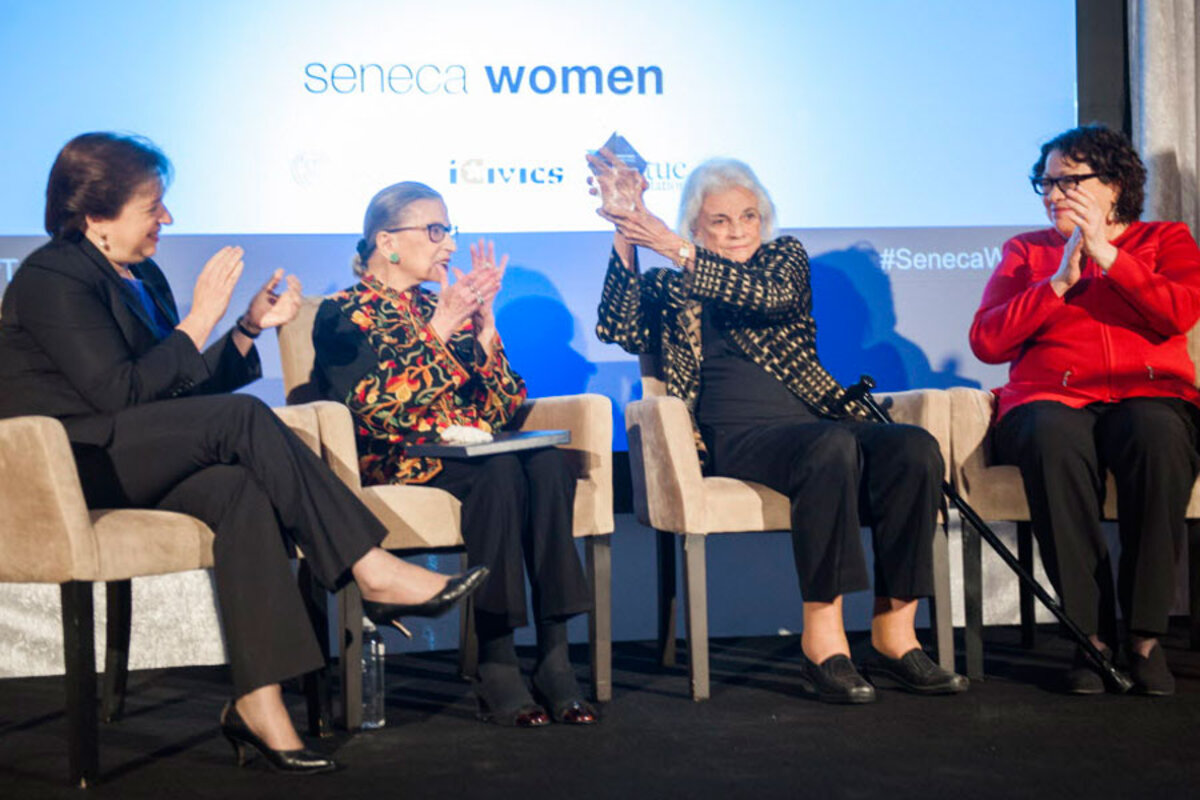Contraception case: On divided court, spotlight shifts to female justices
Loading...
| Washington
It has been less than two months since Antonin Scalia's death, but the absence of the Supreme Court justice – both as one of the court’s most energetic questioners and as the flag bearer of its conservative wing – is already being keenly felt.
There is already evidence of a leftward shift in the court. Experts believe the rest of the term – likely to be played out with just eight justices due to partisan gridlock – could witness the rise of an occasionally vocal but consistently formidable voting bloc made up of the court’s female justices: Elena Kagan, Sonia Sotomayor, and Ruth Bader Ginsburg.
In oral arguments for the first landmark case of the post-Scalia court, concerning abortion regulations in Texas, the female justices dominated the questioning. In arguments for the second potential blockbuster – to be heard on Wednesday, concerning a new challenge to Obamacare's contraception mandate – they are expected to do the same.
And while legal experts don't think the court’s female justices will be this vocal in every case, or will become its new power brokers, they could well be laying the groundwork for a new voting bloc that extends beyond women’s issues and could help guide a more liberal trajectory for the court.
"I could see if there are issues that are of particular concern to one of the women, that the other two women will come on-board," says Karen O'Connor, a professor of political science and founder of the Women and Politics Institute at American University in Washington.
"Political scientists that justices are strategic voters," she adds. "If that theory holds true, I'd see the women coming together on most of the cases that are before the court."
It undoubtedly helps that the three women are cut from the same ideological cloth. Along with Justice Stephen Breyer, they form the court's liberal wing. In the month since Justice Scalia’s death a series of low-profile orders have hinted at a new leftish tilt for the court. It reversed an Alabama Supreme Court ruling , and reversed a Louisiana man's . Chief Justice John Roberts also to block a new mercury emissions regulation while legal challenges proceed, just a month after the full court granted a similar request blocking the implementation of President Obama's Clean Power Plan regulations.
Texas abortion case
Perhaps the most public signal that the high court’s three female justices are having a more outsized influence on the court came during arguments in the Texas abortion case.
The three women, to quote multiple sources, have "never been shrinking violets," but the questions they delivered during those arguments surprised multiple veteran court watchers, and illustrated that, when they feel compelled to, they can dictate court proceedings to their liking.
"It felt as if, for the first time in history, the gender playing field at the high court was finally leveled, and as a consequence the Court's female justices were emboldened to just ignore the rules," wrote Dahlia Lithwick .
"Time limits were flouted to such a degree that [Chief Justice Roberts] pretty much gave up enforcing them," she added. "There was something wonderful and symbolic about Roberts losing almost complete control over the court's indignant women, who are just not inclined to play nice anymore."
The landmark case to be argued on Wednesday, , is expected to follow a similar pattern.
The case concerns whether religious nonprofits should be forced to comply with the contraception mandate of the Affordable Care Act. Two years ago the court ruled in a similar case, Burwell v. Hobby Lobby Stores, that closely-held religious for-profit businesses could not be required to provide access to contraceptives.
But experts believe Wednesday's arguments will play out more like they did in the Texas case than in Hobby Lobby.
"I could see that [happening] again" during arguments on Wednesday, said Carrie Severino, chief counsel and policy director of the conservative Judicial Crisis Network, on a conference call with reporters. "Without Justice Scalia in and providing that counterbalance, it leaves the right wing of the court a little short on people bringing up questions."
The power of the swing vote
Yet while Scalia's death may have allowed the female justices to occupy the microphone during oral arguments more than in the past, experts say that in terms of actual decision-making, the power brokers on the bench remain the same: Roberts and Justice Anthony Kennedy, who has been the Court’s "swing vote" for .
"There isn't power on the super left of court, there's not power on the super right of court," says Jessica Waters, an adjunct professor in the Washington College of Law at American University.
"Power is when you're the decision-maker, and that’s coming from the middle," she adds. "It's coming from Roberts sometimes. It's certainly coming from Kennedy."
But given the implications of a 4-to-4 vote – in which case the court would write no opinion and the lower court ruling would stand – a bloc of three female justices could find itself on the majority side of most narrow decisions, if only to avoid the nationwide judicial uncertainty of a tie vote, experts say.
The Zubik case could test this theory. The case is a consolidation of seven separate petitions from seven separate jurisdictions, but the lower court rulings have gone in conflicting directions. If there is a 4-to-4 tie (a likely scenario, given that Hobby Lobby was decided by a 5-to-4 vote, with Scalia in the majority), the contraception mandate would apply in some parts of the country and not others.
"One thing I'm going to be curious about is whether any of the conservative justices, particularly Chief Justice Roberts, if they seem to be really interested in the confusion that a 4-4 ruling would create," says Rick Garnett, a professor at the University of Notre Dame Law School in Indiana who has signed onto an amicus brief supporting the petitioners in the case.
"If you hear [Roberts] asking lot about that, it would suggest he's going to go along with the administration just so the court gets a clear answer," he adds.
Keenly felt role
One group that will almost certainly not compromise, at least in this case, are the court's female justices, according to Professor O'Connor.
"All three women," she says, "truly believe that they are the representatives, if you will, of all of the women in the United States. And I think they feel that role very keenly."
That marks an evolution in thought from the 1980s, when Justice Sandra Day O’Connor, the first female justice appointed to the court, repudiated the theory that being a woman affected her jurisprudence. In 1991, Justice O’Connor said at a lecture that “asking whether women attorneys speak with ‘a different voice’ than men do is a question that is both dangerous and unanswerable.”
A decade later, Sotomayor said in a speech, “I would hope that a wise Latina woman with the richness of her experiences would more often than not reach a better conclusion than a white male who hasn’t lived that life.” At her confirmation hearing, that statement was turned into a weapon against her, and Sotomayor had to repudiate it.
But legal watchers say the evidence is clear that female justices bring a different worldview shaped by their own life experience.
“The law is not different for men and for women, and Justices O’Connor and Ginsburg were not morally different from their peers. But they had life experiences as women. And their lives made their work different,” wrote Linda Hirshman, author of the book, “Sisters in Law,” in , arguing that Sotomayor’s 2014 dissent on an affirmative action case was a clear evidence of that fact.
The three women have much in common politically, but this bond in particular could see them unite even around issues unrelated to women’s health, like the upcoming case challenging the legality of Obama’s executive actions on immigration.
"Justice Sotomayor would [likely] take the lead in terms of arguing for liberalized immigration policies. It would not surprise me that the other women justices support her to show a solidarity among themselves," says O'Connor.
"I do think you're going to see a sisterhood, not of the traveling pants, but a sisterhood of the black robes on the court for the remainder of term."





